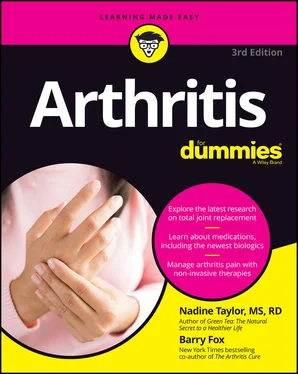Barry Fox - Arthritis For Dummies
Здесь есть возможность читать онлайн «Barry Fox - Arthritis For Dummies» — ознакомительный отрывок электронной книги совершенно бесплатно, а после прочтения отрывка купить полную версию. В некоторых случаях можно слушать аудио, скачать через торрент в формате fb2 и присутствует краткое содержание. Жанр: unrecognised, на английском языке. Описание произведения, (предисловие) а так же отзывы посетителей доступны на портале библиотеки ЛибКат.
- Название:Arthritis For Dummies
- Автор:
- Жанр:
- Год:неизвестен
- ISBN:нет данных
- Рейтинг книги:3 / 5. Голосов: 1
-
Избранное:Добавить в избранное
- Отзывы:
-
Ваша оценка:
- 60
- 1
- 2
- 3
- 4
- 5
Arthritis For Dummies: краткое содержание, описание и аннотация
Предлагаем к чтению аннотацию, описание, краткое содержание или предисловие (зависит от того, что написал сам автор книги «Arthritis For Dummies»). Если вы не нашли необходимую информацию о книге — напишите в комментариях, мы постараемся отыскать её.
Arthritis For Dummies
Arthritis For Dummies
Arthritis For Dummies — читать онлайн ознакомительный отрывок
Ниже представлен текст книги, разбитый по страницам. Система сохранения места последней прочитанной страницы, позволяет с удобством читать онлайн бесплатно книгу «Arthritis For Dummies», без необходимости каждый раз заново искать на чём Вы остановились. Поставьте закладку, и сможете в любой момент перейти на страницу, на которой закончили чтение.
Интервал:
Закладка:
Your parents had it: There appears to be a genetic component to osteoarthritis; in fact, one study concluded that genes were responsible for 50 percent of hip osteoarthritis cases. Osteoarthritis in the hands is also believed to be at least partially due to genetics. An inherited tendency toward defective cartilage or poorly structured joints can certainly put you on the road to osteoarthritis, although you won’t necessarily develop it.
You’re overweight: Excess weight puts a great deal of strain on the weight-bearing joints — the hips, knees, and ankles. For every ten pounds of excess weight you carry, you increase the force exerted on these joints anywhere from four to ten times, depending upon the type of activity. Researchers have found a definite link between being overweight and osteoarthritis, especially involving the knee joints.
 Using chopsticks can actually increase your risk of developing OA of the hand! Researchers studying 2,507 60-year-old residents of Beijing, China found significantly more OA in the first, second, and third fingers of the hand that used chopsticks than the non-chopstick-using hand. Repeated mechanical stress to these joints, via chopstick use, is believed to be the culprit.
Using chopsticks can actually increase your risk of developing OA of the hand! Researchers studying 2,507 60-year-old residents of Beijing, China found significantly more OA in the first, second, and third fingers of the hand that used chopsticks than the non-chopstick-using hand. Repeated mechanical stress to these joints, via chopstick use, is believed to be the culprit.
Determining Whether It Really Is Osteoarthritis
Nearly 50 percent of those suffering from osteoarthritis don’t know what kind of arthritis they have and therefore can’t make good decisions about their treatment.
Say your knee hurts. The first time that you visit your doctor complaining of the pain, they put you through the standard round of interviews, examinations, and tests. They review your medical history and makes a detailed list of the injuries you have sustained, especially to your knees. They may palpate your knee to see if it’s painful to the touch, carefully bend your knee and straighten it several times (it may hurt a little and seem stiff), and listen for cracking or popping in the joint. If your arthritis appears to be inflammatory, your doctor may send you to the lab to get some blood drawn to rule out other forms of the disease. At this point, all your doctor has to go on is a history of knee injuries, some pain and stiffness upon movement, and a little cracking in the joint. Your symptoms may sound like osteoarthritis, but may not yet be a sure thing.
The next step would be to order an X-ray of your knee to see if one or more of the following signs are present:
Cartilage degradation
Cartilage overgrowth
Narrowing of the joint space
Bone spurs
Bits of cartilage or bone floating in the joint fluid
Joint deformity
Treating Osteoarthritis
After a diagnosis of osteoarthritis is confirmed, you and your doctor can begin to devise a treatment program — confident that you’re headed in the right direction. Although the symptoms may not disappear completely, you still have a good chance that, with proper treatment, your pain will diminish significantly and joint degradation can be kept to a minimum. (Check out “Keeping OA at bay: Mark’s Story” at the end of the chapter to see how a 35-year-old man successfully took charge of his arthritis.)
A good treatment plan for osteoarthritis should include the following elements to help you manage pain and discomfort on a daily basis.
Muting the pain with medication
Both prescription and over-the-counter remedies are commonly used to relieve osteoarthritis pain. Whether prescription or nonprescription, the drugs usually fall into one or two categories:
Acetaminophen: These relieve pain and fever, but don’t reduce inflammation (for example, Tylenol, Liquiprin, or Datril).
Nonsteroidal anti-inflammatories or NSAIDs: These relieve pain and fever and do reduce inflammation (for example, aspirin, Advil, Aleve, or Motrin). However, NSAIDs may produce side effects that, when combined with other health conditions like heart disease, kidney disease, or stomach ulcersdon’t make them the safest choice.
Another medication that has been approved to treat chronic pain, including OA pain, doesn’t fall into the above categories. Duloxetine (Cymbalta) is a serotonin-norepinephrine reuptake inhibitor (SNRI) used primarily to treat depression and anxiety. But it is also used to decrease pain due to arthritis, fibromyalgia, or chronic back pain, as well as nerve pain due to diabetes.
If your joints are swollen, your doctor may prescribe an NSAID. If swelling isn’t a problem, they may give you acetaminophen. And if you have chronic pain, they may prescribe one of many prescription pain relievers, including Duloxetine.
 To avoid drug interactions, overdoses, or side effects, make sure you check with your doctor before taking any over-the-counter medications. (See Chapter 8for more information on medicines.)
To avoid drug interactions, overdoses, or side effects, make sure you check with your doctor before taking any over-the-counter medications. (See Chapter 8for more information on medicines.)
Lubricating your joints with exercise
If you’re in pain, you probably want to stop moving, and it’s certainly advisable for you to rest your joints when you’re feeling achy. But too much sitting around can actually be the worst thing for you in the long run. Exercise is a great way to “oil and feed” the cartilage. Underexercised joints don’t get the lubricating and nourishing benefits of the in-and-out action of the joint fluid, so cartilage can become thin and dry, losing its resilience and capability to cushion the bones.
Include three types of exercises in your overall physical fitness program:
Flexibility exercises: You should do stretching, bending, and twisting exercises every day to increase your range-of-motion and reduce stiffness. Flexibility exercises help keep your joints loose and flexible.
Strengthening exercises: Weight lifting or isometric exercises should be done every other day to build your muscles and help keep your joint-supporting structures stable. These types of exercises help increase your muscle strength.
Endurance (aerobic) exercises: These should be done at least three times a week for at least 20 to 30 minutes each session to increase overall fitness, strengthen your cardiovascular system, and keep your weight under control. Brisk walking (especially up hills), jogging, cycling, dancing, swimming, and so on, all help to increase your fitness and capacity for exercise.
 Before starting a new exercise program, get a referral to a physical therapist to find out which kinds of exercise and levels of activity are appropriate for you. Doing the wrong exercises — or doing the right exercises in the wrong way — can cause you further injury. (See Chapter 12for more information on exercise.)
Before starting a new exercise program, get a referral to a physical therapist to find out which kinds of exercise and levels of activity are appropriate for you. Doing the wrong exercises — or doing the right exercises in the wrong way — can cause you further injury. (See Chapter 12for more information on exercise.)
Protecting your joints through good alignment
Applying the techniques of body alignment, proper standing, sitting, walking and running, and correct lifting can go a long way toward sparing your joints from excessive wear and tear and protecting them from future injury. You may also find it helpful to wrap affected joints with elastic supports or take a load off with assistive devices, such as canes or crutches. Other joint-protective techniques include alternating your activities with rest periods, varying your tasks to avoid too much repetitive stress on any one area, and pacing yourself. Don’t try to do too much at once. (See Chapter 13for more information on joint protection.)
Читать дальшеИнтервал:
Закладка:
Похожие книги на «Arthritis For Dummies»
Представляем Вашему вниманию похожие книги на «Arthritis For Dummies» списком для выбора. Мы отобрали схожую по названию и смыслу литературу в надежде предоставить читателям больше вариантов отыскать новые, интересные, ещё непрочитанные произведения.
Обсуждение, отзывы о книге «Arthritis For Dummies» и просто собственные мнения читателей. Оставьте ваши комментарии, напишите, что Вы думаете о произведении, его смысле или главных героях. Укажите что конкретно понравилось, а что нет, и почему Вы так считаете.












